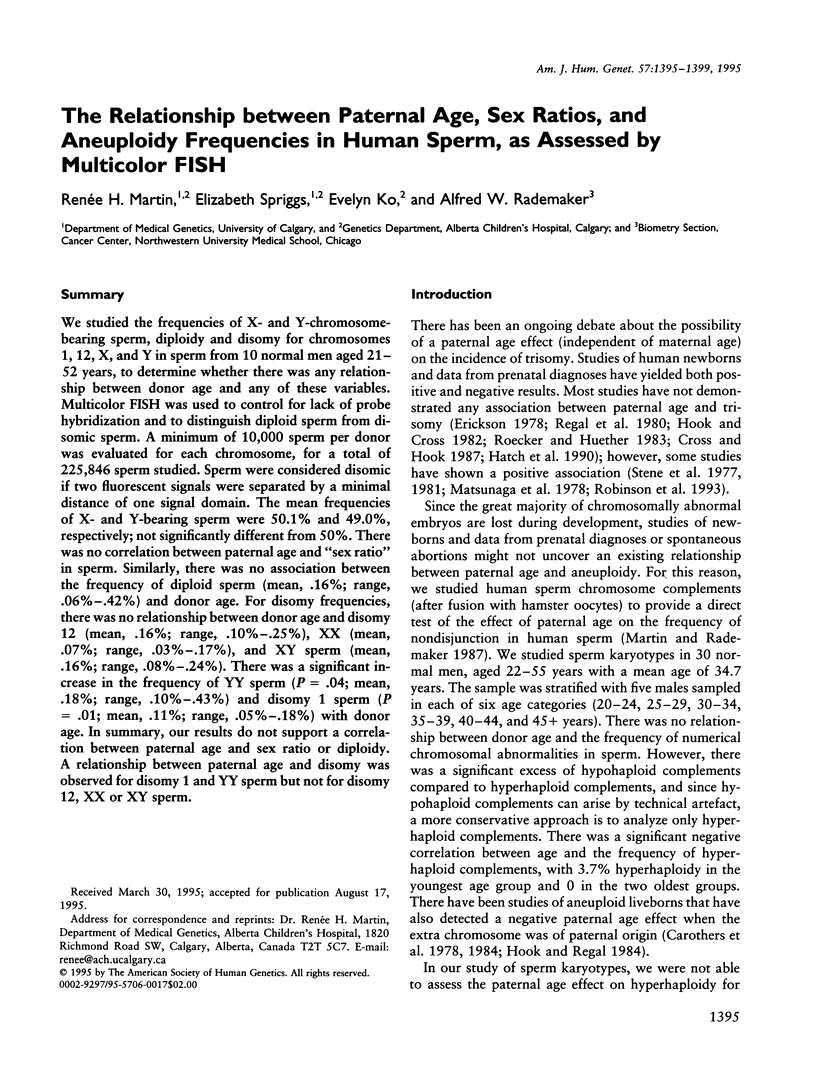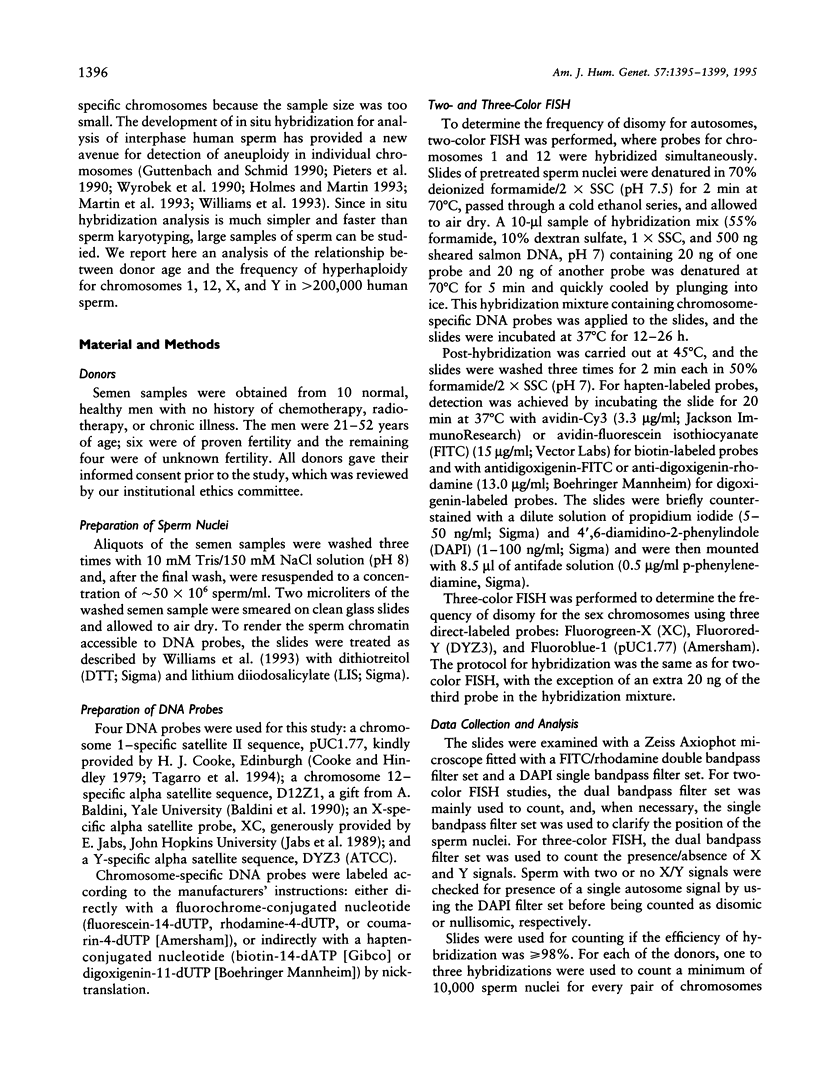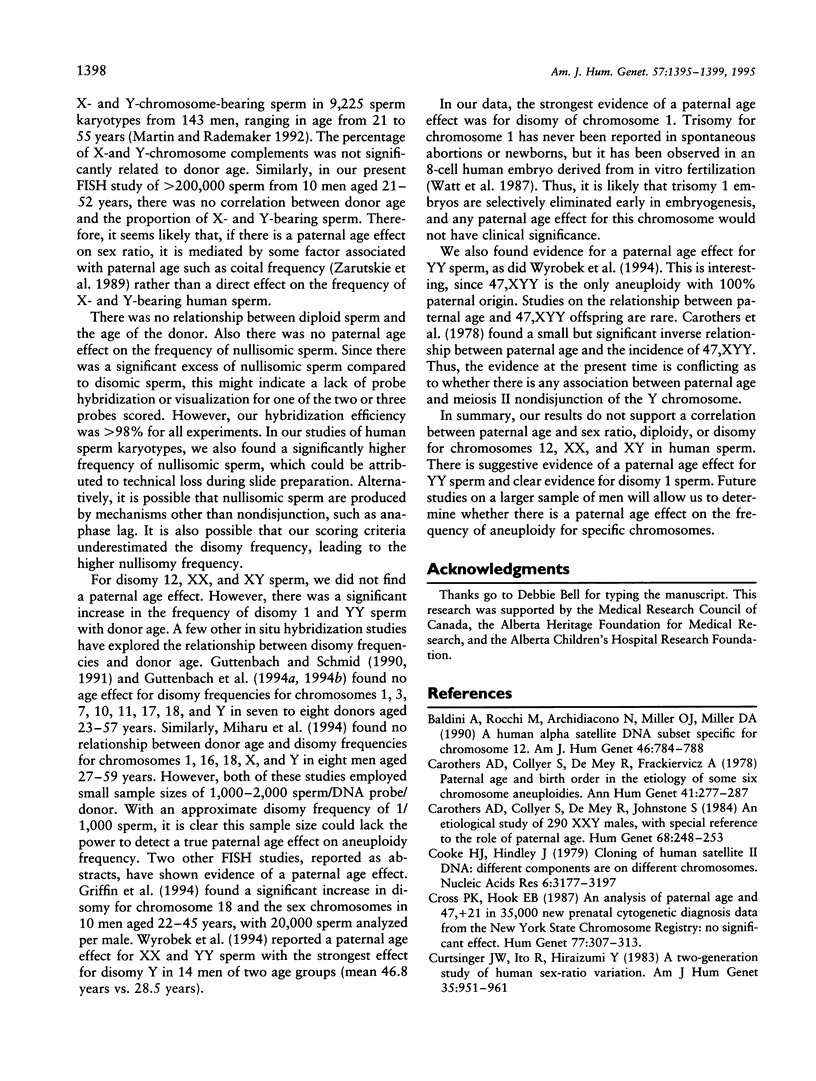Abstract
We studied the frequencies of X- and Y-chromosome-bearing sperm, diploidy and disomy for chromosomes 1, 12, X, and Y in sperm from 10 normal men aged 21-52 years, to determine whether there was any relationship between donor age and any of these variables. Multicolor FISH was used to control for lack of probe hybridization and to distinguish diploid sperm from disomic sperm. A minimum of 10,000 sperm per donor was evaluated for each chromosome, for a total of 225,846 sperm studied. Sperm were considered disomic if two fluorescent signals were separated by a minimal distance of one signal domain. The mean frequencies of X- and Y-bearing sperm were 50.1% and 49.0%, respectively; not significantly different from 50%. There was no correlation between paternal age and "sex ratio" in sperm. Similarly, there was no association between the frequency of diploid sperm (mean, .16%; range, .06-.42%) and donor age. For disomy frequencies, there was no relationship between donor age and disomy 12 (mean, .16%; range, .10%-.25%), XX (mean, .07%; range, .03%-.17%), and XY sperm (mean, .16%; range, .08%-.24%). There was a significant increase in the frequency of YY sperm (P = .04; mean, .18%; range, .10%-.43%) and disomy 1 sperm (P = .01; mean, .11%; range, .05%-.18%) with donor age. In summary, our results do not support a correlation between paternal age and sex ratio or diploidy.
Full text
PDF




Selected References
These references are in PubMed. This may not be the complete list of references from this article.
- Baldini A., Rocchi M., Archidiacono N., Miller O. J., Miller D. A. A human alpha satellite DNA subset specific for chromosome 12. Am J Hum Genet. 1990 Apr;46(4):784–788. [PMC free article] [PubMed] [Google Scholar]
- Carothers A. D., Collyer S., De Mey R., Frackiewicz A. Parental age and birth order in the aetiology of some sex chromosome aneuploidies. Ann Hum Genet. 1978 Jan;41(3):277–287. doi: 10.1111/j.1469-1809.1978.tb01895.x. [DOI] [PubMed] [Google Scholar]
- Carothers A. D., Collyer S., De Mey R., Johnstone I. An aetiological study of 290 XXY males, with special reference to the role of paternal age. Hum Genet. 1984;68(3):248–253. doi: 10.1007/BF00418395. [DOI] [PubMed] [Google Scholar]
- Cooke H. J., Hindley J. Cloning of human satellite III DNA: different components are on different chromosomes. Nucleic Acids Res. 1979 Jul 25;6(10):3177–3197. doi: 10.1093/nar/6.10.3177. [DOI] [PMC free article] [PubMed] [Google Scholar]
- Cross P. K., Hook E. B. An analysis of paternal age and 47,+21 in 35,000 new prenatal cytogenetic diagnosis data from the New York State Chromosome Registry: no significant effect. Hum Genet. 1987 Dec;77(4):307–316. doi: 10.1007/BF00291415. [DOI] [PubMed] [Google Scholar]
- Curtsinger J. W., Ito R., Hiraizumi Y. A two-generation study of human sex-ratio variation. Am J Hum Genet. 1983 Sep;35(5):951–961. [PMC free article] [PubMed] [Google Scholar]
- Erickson J. D. Down syndrome, paternal age, maternal age and birth order. Ann Hum Genet. 1978 Jan;41(3):289–298. doi: 10.1111/j.1469-1809.1978.tb01896.x. [DOI] [PubMed] [Google Scholar]
- Guttenbach M., Schakowski R., Schmid M. Incidence of chromosome 3, 7, 10, 11, 17 and X disomy in mature human sperm nuclei as determined by nonradioactive in situ hybridization. Hum Genet. 1994 Jan;93(1):7–12. doi: 10.1007/BF00218904. [DOI] [PubMed] [Google Scholar]
- Guttenbach M., Schmid M. Determination of Y chromosome aneuploidy in human sperm nuclei by nonradioactive in situ hybridization. Am J Hum Genet. 1990 Mar;46(3):553–558. [PMC free article] [PubMed] [Google Scholar]
- Hatch M., Kline J., Levin B., Hutzler M., Warburton D. Paternal age and trisomy among spontaneous abortions. Hum Genet. 1990 Aug;85(3):355–361. doi: 10.1007/BF00206761. [DOI] [PubMed] [Google Scholar]
- Holmes J. M., Martin R. H. Aneuploidy detection in human sperm nuclei using fluorescence in situ hybridization. Hum Genet. 1993 Mar;91(1):20–24. doi: 10.1007/BF00230216. [DOI] [PubMed] [Google Scholar]
- Hook E. B., Cross P. K. Paternal age and Down's syndrome genotypes diagnosed prenatally: no association in New York state data. Hum Genet. 1982;62(2):167–174. doi: 10.1007/BF00282309. [DOI] [PubMed] [Google Scholar]
- Hook E. B., Regal R. R. A search for a paternal-age effect upon cases of 47, +21 in which the extra chromosome is of paternal origin. Am J Hum Genet. 1984 Mar;36(2):413–421. [PMC free article] [PubMed] [Google Scholar]
- Jabs E. W., Goble C. A., Cutting G. R. Macromolecular organization of human centromeric regions reveals high-frequency, polymorphic macro DNA repeats. Proc Natl Acad Sci U S A. 1989 Jan;86(1):202–206. doi: 10.1073/pnas.86.1.202. [DOI] [PMC free article] [PubMed] [Google Scholar]
- James W. H., Rostron J. Parental age, parity and sex ratio in births in England and Wales, 1968-77. J Biosoc Sci. 1985 Jan;17(1):47–56. doi: 10.1017/s0021932000015467. [DOI] [PubMed] [Google Scholar]
- Martin R. H., Ko E., Chan K. Detection of aneuploidy in human interphase spermatozoa by fluorescence in situ hybridization (FISH). Cytogenet Cell Genet. 1993;64(1):23–26. doi: 10.1159/000133552. [DOI] [PubMed] [Google Scholar]
- Martin R. H., Rademaker A. W. The effect of age on the frequency of sperm chromosomal abnormalities in normal men. Am J Hum Genet. 1987 Sep;41(3):484–492. [PMC free article] [PubMed] [Google Scholar]
- Matsunaga E., Tonomura A., Oishi H., Kikuchi Y. Reexamination of paternal age effect in Down's syndrome. Hum Genet. 1978 Feb 16;40(3):259–268. doi: 10.1007/BF00272186. [DOI] [PubMed] [Google Scholar]
- Pieters M. H., Geraedts J. P., Meyer H., Dumoulin J. C., Evers J. L., Jongbloed R. J., Nederlof P. M., van der Flier S. Human gametes and zygotes studied by nonradioactive in situ hybridization. Cytogenet Cell Genet. 1990;53(1):15–19. doi: 10.1159/000132886. [DOI] [PubMed] [Google Scholar]
- Regal R. R., Cross P. K., Lamson S. H., Hook E. B. A search for evidence for a paternal age effect independent of a maternal age effect in birth certificate reports of Down's syndrome in New York state. Am J Epidemiol. 1980 Nov;112(5):650–655. doi: 10.1093/oxfordjournals.aje.a113037. [DOI] [PubMed] [Google Scholar]
- Robinson W. P., Lorda-Sanchez I., Malcolm S., Langlois S., Schuffenhauer S., Knoblauch H., Horsthemke B., Schinzel A. A. Increased parental ages and uniparental disomy 15: a paternal age effect? Eur J Hum Genet. 1993;1(4):280–286. doi: 10.1159/000472425. [DOI] [PubMed] [Google Scholar]
- Roecker G. O., Huether C. A. An analysis for paternal-age effect in Ohio's Down syndrome births, 1970-1980. Am J Hum Genet. 1983 Nov;35(6):1297–1306. [PMC free article] [PubMed] [Google Scholar]
- Ruder A. Paternal-age and birth-order effect on the human secondary sex ratio. Am J Hum Genet. 1985 Mar;37(2):362–372. [PMC free article] [PubMed] [Google Scholar]
- Stene J., Stene E., Stengel-Rutkowski S., Murken J. D. Paternal age and Down's syndrome: data from prenatal diagnoses (DFG). Hum Genet. 1981;59(2):119–124. doi: 10.1007/BF00293059. [DOI] [PubMed] [Google Scholar]
- Tagarro I., Fernández-Peralta A. M., González-Aguilera J. J. Chromosomal localization of human satellites 2 and 3 by a FISH method using oligonucleotides as probes. Hum Genet. 1994 Apr;93(4):383–388. doi: 10.1007/BF00201662. [DOI] [PubMed] [Google Scholar]
- Watt J. L., Templeton A. A., Messinis I., Bell L., Cunningham P., Duncan R. O. Trisomy 1 in an eight cell human pre-embryo. J Med Genet. 1987 Jan;24(1):60–64. doi: 10.1136/jmg.24.1.60. [DOI] [PMC free article] [PubMed] [Google Scholar]
- Williams B. J., Ballenger C. A., Malter H. E., Bishop F., Tucker M., Zwingman T. A., Hassold T. J. Non-disjunction in human sperm: results of fluorescence in situ hybridization studies using two and three probes. Hum Mol Genet. 1993 Nov;2(11):1929–1936. doi: 10.1093/hmg/2.11.1929. [DOI] [PubMed] [Google Scholar]
- Wyrobek A. J., Alhborn T., Balhorn R., Stanker L., Pinkel D. Fluorescence in situ hybridization to Y chromosomes in decondensed human sperm nuclei. Mol Reprod Dev. 1990 Nov;27(3):200–208. doi: 10.1002/mrd.1080270304. [DOI] [PubMed] [Google Scholar]
- Zarutskie P. W., Muller C. H., Magone M., Soules M. R. The clinical relevance of sex selection techniques. Fertil Steril. 1989 Dec;52(6):891–905. doi: 10.1016/s0015-0282(16)53148-3. [DOI] [PubMed] [Google Scholar]


